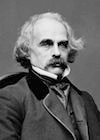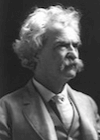
Hans Christian Andersen, born in Denmark in 1805, practically invented the writing of eventyrs; the adventure fairy tale, or fantastic tale. Although he wrote a broad range of work, including plays, travelogues, novels, and poems, it was his fairy tales that became culturally iconic in the Western world. His tales transcend age barriers, national and cultural boundaries and have been translated into more than 125 languages. Many of his stories are featured in our collection of Favorite Fairy Tales.
His stories have inspired countless plays, ballets, and movies. Who hasn't read or seen an animated movie adaptation of Thumbelina (1835), The Emperor's New Clothes (1837), The Little Mermaid (1836), and The Princess and the Pea (1835?)
Andersen also blessed us with one of the saddest but most poignant and beautiful Christmas stories of all time, The Little Match Girl (also known as The Little Matchstick Girl). We encourage teachers and students to use our Study Guide.
Andersen has a number of exemplary, lesser known stories, worthy of your attention and offered right here on American Literature.com. Consider these entertaining tales:
- The Brave Tin Soldier
- The Last Dream of Old Oak
- The Shirt-Collar
- The Galoshes of Fortune (1838)
- The Saucy Boy (1835)
- The Old Bachelor's Nightcap
- The Swineherd (1841)
- The Travelling Companion (1835)
In 1847 on his first visit to Britain, Andersen met Charles Dickens. Andersen wrote in his diary, "We had come to the veranda, I was so happy to see and speak to England's now living writer, whom I love the most." ("Hcandersen-homepage.dk. 2001-12-30). Both authors focused on the poor and underprivileged, tales of transcendence to a better life through hard work, guts, and good fortune.
Andersen's stories laid the groundwork for other children's classics, such as The Wind in the Willows by Kenneth Grahame and Winnie the Pooh by A.A. Milne. It's as if Andersen was a pre-ordained Disney writer, with his penchant for making inanimate objects, like toys, come to life and have adventures appealing to people of all ages he created a series of timeless classics. Andersen was a master writer whose work and themes have been emulated throughout time, and through a broad spectrum of platforms.
Andersen died on August 4, 1875 in Copenhagen, having never fully recovered from an injury he sustained after falling out of his bed two years earlier.









